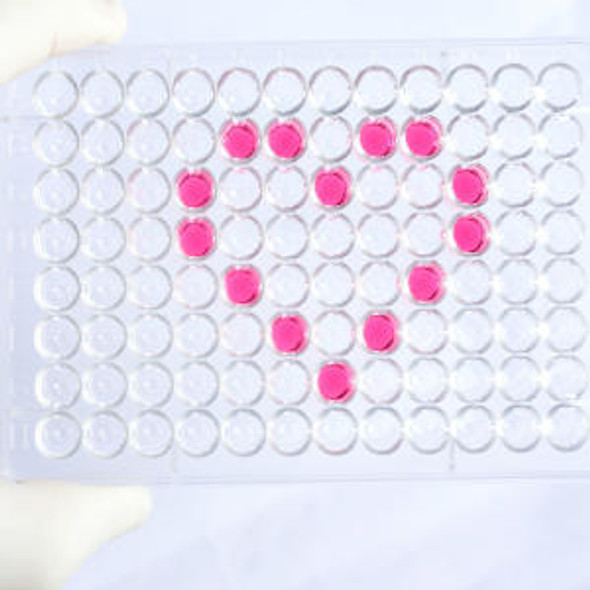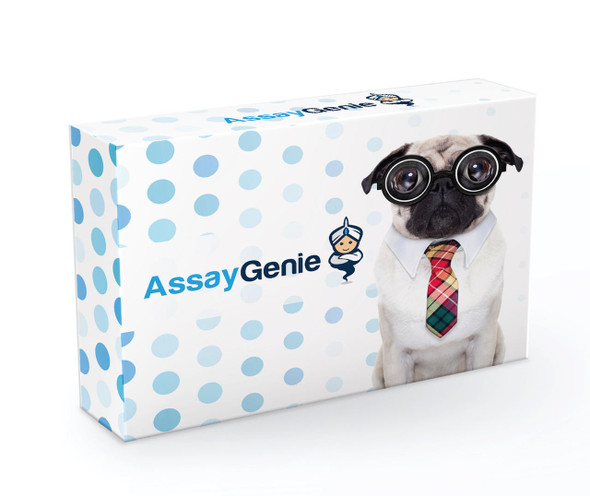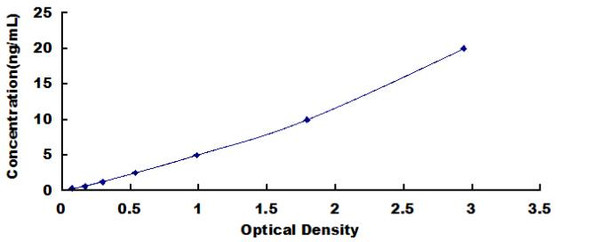Human Immunology ELISA Kits 1
Human LBP (Lipopolysaccharide Binding Protein) CLIA Kit (HUES01191)
- SKU:
- HUES01191
- Product Type:
- ELISA Kit
- ELISA Type:
- CLIA Kit
- Size:
- 96 Assays
- Sensitivity:
- 0.38ng/mL
- Range:
- 0.63-40ng/mL
- ELISA Type:
- Sandwich
- Reactivity:
- Human
- Sample Type:
- Serum, plasma and other biological fluids
- Research Area:
- Immunology
Description
| Assay type: | Sandwich |
| Format: | 96T |
| Assay time: | 4.5h |
| Reactivity: | Human |
| Detection method: | Chemiluminescence |
| Detection range: | 0.63-40 ng/mL |
| Sensitivity: | 0.38 ng/mL |
| Sample volume: | 100µL |
| Sample type: | Serum, plasma and other biological fluids |
| Repeatability: | CV < 15% |
| Specificity: | This kit recognizes Human LBP in samples. No significant cross-reactivity or interference between Human LBP and analogues was observed. |
This kit uses Sandwich-CLIA as the method. The micro CLIA plate provided in this kit has been pre-coated with an antibody specific to Human LBP. Standards or samples are added to the appropriate micro CLIA plate wells and combined with the specific antibody. Then a biotinylated detection antibody specific for Human LBP and Avidin-Horseradish Peroxidase (HRP) conjugate are added to each micro plate well successively and incubated. Free components are washed away. The substrate solution is added to each well. Only those wells that contain Human LBP, biotinylated detection antibody and Avidin-HRP conjugate will appear fluorescence. The Relative light unit (RLU) value is measured spectrophotometrically by the Chemiluminescence immunoassay analyzer. The RLU value is positively associated with the concentration of Human LBP. The concentration of Human LBP in the samples can be calculated by comparing the RLU of the samples to the standard curve.
| UniProt Protein Function: | LBP: Binds to the lipid A moiety of bacterial lipopolysaccharides (LPS), a glycolipid present in the outer membrane of all Gram-negative bacteria. The LBP/LPS complex seems to interact with the CD14 receptor. Belongs to the BPI/LBP/Plunc superfamily. BPI/LBP family. |
| UniProt Protein Details: | Protein type:Secreted, signal peptide; Secreted Chromosomal Location of Human Ortholog: 20q11. 23 Cellular Component: extracellular space; cell surface; extracellular region Molecular Function:protein binding; lipopolysaccharide binding; receptor binding Biological Process: positive regulation of tumor necrosis factor biosynthetic process; detection of molecule of bacterial origin; positive regulation of toll-like receptor 4 signaling pathway; positive regulation of interleukin-6 production; response to lipopolysaccharide; negative regulation of tumor necrosis factor production; positive regulation of tumor necrosis factor production; defense response to Gram-negative bacterium; leukocyte chemotaxis during inflammatory response; positive regulation of chemokine production; positive regulation of interleukin-8 production; lipopolysaccharide transport; defense response to Gram-positive bacterium; macrophage activation during immune response; lipopolysaccharide-mediated signaling pathway; toll-like receptor signaling pathway; acute-phase response; innate immune response; cellular defense response; opsonization; toll-like receptor 4 signaling pathway; positive regulation of macrophage activation |
| NCBI Summary: | The protein encoded by this gene is involved in the acute-phase immunologic response to gram-negative bacterial infections. Gram-negative bacteria contain a glycolipid, lipopolysaccharide (LPS), on their outer cell wall. Together with bactericidal permeability-increasing protein (BPI), the encoded protein binds LPS and interacts with the CD14 receptor, probably playing a role in regulating LPS-dependent monocyte responses. Studies in mice suggest that the encoded protein is necessary for the rapid acute-phase response to LPS but not for the clearance of LPS from circulation. This protein is part of a family of structurally and functionally related proteins, including BPI, plasma cholesteryl ester transfer protein (CETP), and phospholipid transfer protein (PLTP). [provided by RefSeq, Apr 2012] |
| UniProt Code: | P18428 |
| NCBI GenInfo Identifier: | 116242615 |
| NCBI Gene ID: | 3929 |
| NCBI Accession: | P18428. 3 |
| UniProt Secondary Accession: | P18428,O43438, Q92672, Q9H403, Q9UD66, B2R938, |
| UniProt Related Accession: | P18428 |
| Molecular Weight: | 53,384 Da |
| NCBI Full Name: | Lipopolysaccharide-binding protein |
| NCBI Synonym Full Names: | lipopolysaccharide binding protein |
| NCBI Official Symbol: | LBP |
| NCBI Official Synonym Symbols: | BPIFD2 |
| NCBI Protein Information: | lipopolysaccharide-binding protein; LPS-binding protein; BPI fold containing family D, member 2 |
| UniProt Protein Name: | Lipopolysaccharide-binding protein |
| Protein Family: | Lipopolysaccharide-binding protein |
| UniProt Gene Name: | LBP |
| UniProt Entry Name: | LBP_HUMAN |
As the RLU values of the standard curve may vary according to the conditions of the actual assay performance (e. g. operator, pipetting technique, washing technique or temperature effects), the operator should establish a standard curve for each test. Typical standard curve and data is provided below for reference only.
| Concentration (ng/mL) | RLU | Average | Corrected |
| 40 | 35607 37469 | 36538 | 36508 |
| 20 | 14001 14631 | 14316 | 14286 |
| 10 | 6435 6111 | 6273 | 6243 |
| 5 | 2865 3171 | 3018 | 2988 |
| 2.5 | 1627 1537 | 1582 | 1552 |
| 1.25 | 972 852 | 912 | 882 |
| 0.63 | 563 615 | 589 | 559 |
| 0 | 30 30 | 30 | -- |
Precision
Intra-assay Precision (Precision within an assay): 3 samples with low, mid range and high level Human LBP were tested 20 times on one plate, respectively.
Inter-assay Precision (Precision between assays): 3 samples with low, mid range and high level Human LBP were tested on 3 different plates, 20 replicates in each plate.
| Intra-assay Precision | Inter-assay Precision | |||||
| Sample | 1 | 2 | 3 | 1 | 2 | 3 |
| n | 20 | 20 | 20 | 20 | 20 | 20 |
| Mean (ng/mL) | 1.88 | 4.39 | 19.45 | 1.73 | 4.50 | 18.42 |
| Standard deviation | 0.20 | 0.46 | 1.87 | 0.19 | 0.35 | 1.27 |
| C V (%) | 10.64 | 10.48 | 9.61 | 10.98 | 7.78 | 6.89 |
Recovery
The recovery of Human LBP spiked at three different levels in samples throughout the range of the assay was evaluated in various matrices.
| Sample Type | Range (%) | Average Recovery (%) |
| Serum (n=5) | 99-113 | 106 |
| EDTA plasma (n=5) | 97-110 | 104 |
| Cell culture media (n=5) | 92-104 | 98 |
Linearity
Samples were spiked with high concentrations of Human LBP and diluted with Reference Standard & Sample Diluent to produce samples with values within the range of the assay.
| Serum (n=5) | EDTA plasma (n=5) | Cell culture media (n=5) | ||
| 1:2 | Range (%) | 96-114 | 88-102 | 89-105 |
| Average (%) | 104 | 94 | 96 | |
| 1:4 | Range (%) | 94-106 | 99-114 | 99-113 |
| Average (%) | 100 | 106 | 105 | |
| 1:8 | Range (%) | 88-100 | 92-104 | 86-98 |
| Average (%) | 93 | 97 | 91 | |
| 1:16 | Range (%) | 86-99 | 86-99 | 94-109 |
| Average (%) | 92 | 93 | 100 |
An unopened kit can be stored at 4°C for 1 month. If the kit is not used within 1 month, store the items separately according to the following conditions once the kit is received.
| Item | Specifications | Storage |
| Micro CLIA Plate(Dismountable) | 8 wells ×12 strips | -20°C, 6 months |
| Reference Standard | 2 vials | |
| Concentrated Biotinylated Detection Ab (100×) | 1 vial, 120 µL | |
| Concentrated HRP Conjugate (100×) | 1 vial, 120 µL | -20°C(shading light), 6 months |
| Reference Standard & Sample Diluent | 1 vial, 20 mL | 4°C, 6 months |
| Biotinylated Detection Ab Diluent | 1 vial, 14 mL | |
| HRP Conjugate Diluent | 1 vial, 14 mL | |
| Concentrated Wash Buffer (25×) | 1 vial, 30 mL | |
| Substrate Reagent A | 1 vial, 5 mL | 4°C (shading light) |
| Substrate Reagent B | 1 vial, 5 mL | 4°C (shading light) |
| Plate Sealer | 5 pieces | |
| Product Description | 1 copy | |
| Certificate of Analysis | 1 copy |
- Set standard, test sample and control (zero) wells on the pre-coated plate and record theirpositions. It is recommended to measure each standard and sample in duplicate. Note: addall solutions to the bottom of the plate wells while avoiding contact with the well walls. Ensuresolutions do not foam when adding to the wells.
- Aliquot 100 µL of standard solutions into the standard wells.
- Add 100 µL of Sample / Standard dilution buffer into the control (zero) well.
- Add 100 µL of properly diluted sample (serum, plasma, tissue homogenates and otherbiological fluids. ) into test sample wells.
- Cover the plate with the sealer provided in the kit and incubate for 90 min at 37 °C.
- Aspirate the liquid from each well, do not wash. Immediately add 100 µL of BiotinylatedDetection Ab working solution to each well. Cover the plate with a plate seal and gently mix. Incubate for 1 hour at 37 °C.
- Aspirate or decant the solution from the plate and add 350 µL of wash buffer to each welland incubate for 1-2 minutes at room temperature. Aspirate the solution from each well andclap the plate on absorbent filter paper to dry. Repeat this process 3 times. Note: a microplatewasher can be used in this step and other wash steps.
- Add 100 µL of HRP Conjugate working solution to each well. Cover with a plate seal andincubate for 30 min at 37 °C.
- Aspirate or decant the solution from each well. Repeat the wash process for five times asconducted in step 7.
- Add 100 µL of Substrate mixture solution to each well. Cover with a new plate seal andincubate for no more than 5 min at 37 °C. Protect the plate from light.
- Determine the RLU value of each well immediately.






